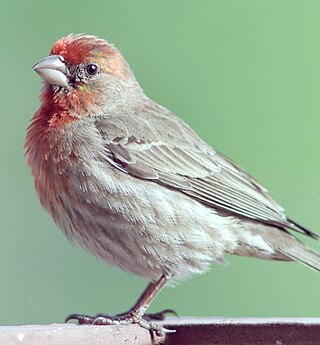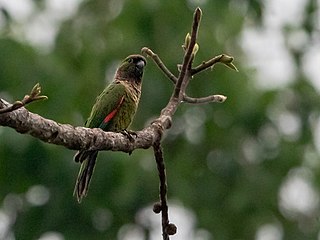
Poultry are domesticated birds kept by humans for the purpose of harvesting animal products such as meat, eggs or feathers. The practice of raising poultry is known as poultry farming. These birds are most typically members of the superorder Galloanserae (fowl), especially the order Galliformes. The term also includes waterfowls of the family Anatidae but does not include wild birds hunted for food known as game or quarry.

The American goldfinch is a small North American bird in the finch family. It is migratory, ranging from mid-Alberta to North Carolina during the breeding season, and from just south of the Canada–United States border to Mexico during the winter.

Bird feeding is the activity of feeding wild birds, often by means of bird feeders. With a recorded history dating to the 6th century, the feeding of wild birds has been encouraged and celebrated in the United States and United Kingdom, with it being the United States' second most popular hobby having National Bird-Feeding Month congressionally decreed in 1994. Various types of food are provided by various methods; certain combinations of food and method of feeding are known to attract certain bird species.

Animal husbandry is the branch of agriculture concerned with animals that are raised for meat, fibre, milk, or other products. It includes day-to-day care, management, production, nutrition, selective breeding, and the raising of livestock. Husbandry has a long history, starting with the Neolithic Revolution when animals were first domesticated, from around 13,000 BC onwards, predating farming of the first crops. By the time of early civilisations such as ancient Egypt, cattle, sheep, goats, and pigs were being raised on farms.

The western capercaillie, also known as the Eurasian capercaillie, wood grouse, heather cock, cock-of-the-woods, or simply capercaillie, is a heavy member of the grouse family and the largest of all extant grouse species. The heaviest-known specimen, recorded in captivity, had a weight of 7.2 kilograms. Found across Europe and the Palearctic, this primarily-ground-dwelling forest grouse is renowned for its courtship display. The bird shows extreme sexual dimorphism, with males nearly twice the size of females. The global population is listed as "least concern" under the IUCN, although the populations of central Europe are declining and fragmented, or possibly extirpated.

The cirl bunting, , is a passerine bird in the bunting family Emberizidae, a group now separated by most modern authors from the finches, Fringillidae.

The House finch is a North American bird in the finch family. It is native to Mexico and southwestern United States, but has since been introduced to the eastern part of North America and Hawaii; it is now found year-round in all parts of the United States and most of Mexico, with some residing near the border of Canada. There are estimated to be 40 million house finches across North America, making it the second-most populous finch, just behind the American goldfinch. The house finch and the other two American rosefinches are placed in the genus Haemorhous.

A birdfeeder, bird table, or tray feeder is a device placed outdoors to supply bird food to birds. The success of a bird feeder in attracting birds depends upon its placement and the kinds of foods offered, as different species have different preferences.

A companion parrot is a parrot kept as a pet that interacts abundantly with its human counterpart. Generally, most species of parrot can make excellent companions, but must be carefully managed around other common pet species like dogs and cats as they might be hostile towards them.

The Moluccan eclectus is a parrot native to the Maluku Islands (Moluccas). It is unusual in the parrot family for its extreme sexual dimorphism of the colours of the plumage; the male having a mostly bright emerald green plumage and the female a mostly bright red and purple/blue plumage. Joseph Forshaw, in his book Parrots of the World, noted that the first European ornithologists to see eclectus parrots thought they were of two distinct species. Large populations of this parrot remain, and they are sometimes considered pests for eating fruit off trees. Some populations restricted to relatively small islands are comparably rare. Their bright feathers are also used by native tribespeople in New Guinea as decorations.

Aquarium fish feed is plant or animal material intended for consumption by pet fish kept in aquariums or ponds. Fish foods normally contain macronutrients, trace elements and vitamins necessary to keep captive fish in good health. Approximately 80% of fishkeeping hobbyists feed their fish exclusively prepared foods that most commonly are produced in flake, pellet or tablet form. Some fish foods also contain additives such as sex hormones or beta carotene to artificially enhance the color of ornamental fish.

The black-capped parakeet, also known as the black-capped conure or rock conure in aviculture, is a parrot native to the south-western Amazon Basin and adjacent east Andean slopes in Peru, Bolivia and Brazil. It has a total length of approximately 25 cm. It is mostly green with off white scalloping on the hindneck and breast and red primary coverts.

Poultry farming is the form of animal husbandry which raises domesticated birds such as chickens, ducks, turkeys and geese to produce meat or eggs for food. Poultry – mostly chickens – are farmed in great numbers. More than 60 billion chickens are killed for consumption annually. Chickens raised for eggs are known as layers, while chickens raised for meat are called broilers.

The spectacled parrotlet is a species of parrot in the family Psittacidae.

Mycoplasma gallisepticum (MG) is a bacterium in the class Mollicutes and the family Mycoplasmataceae. It causes chronic respiratory disease (CRD) in chickens and infectious sinusitis in turkeys, chickens, game birds, pigeons, and passerine birds of all ages. Mycoplasma gallisepticum is a significant pathogen in poultry.
Urban keeping of chickens as pets, for eggs, meat, or for eating pests is popular in urban and suburban areas. Some people sell the eggs for side income.

February is National Bird-Feeding Month in the United States. This celebratory month was created to educate the public on the wild bird feeding and watching hobby. Because of National Bird-Feeding Month, February has become the month most recognized with wild bird feeding promotions and activities.

Manufactured feeds are an important part of modern commercial aquaculture, providing the balanced nutrition needed by farmed fish. The feeds, in the form of granules or pellets, provide the nutrition in a stable and concentrated form, enabling the fish to feed efficiently and grow to their full potential.

Cannibalism in poultry is the act of one individual of a poultry species consuming all or part of another individual of the same species as food. It commonly occurs in flocks of domestic hens reared for egg production, although it can also occur in domestic turkeys, pheasants and other poultry species. Poultry create a social order of dominance known as pecking order. When pressure occurs within the flock, pecking can increase in aggression and escalate to cannibalism. Cannibalism can occur as a consequence of feather pecking which has caused denuded areas and bleeding on a bird's skin. Cannibalism can cause large mortality rates within the flock and large decreases in production due to the stress it causes. Vent pecking, sometimes called 'cloacal cannibalism', is considered to be a separate form of cannibalistic pecking as this occurs in well-feathered birds and only the cloaca is targeted. There are several causes that can lead to cannibalism such as: light and overheating, crowd size, nutrition, injury/death, genetics and learned behaviour. Research has been conducted to attempt to understand why poultry engage in this behaviour, as it is not totally understood. There are known methods of control to reduce cannibalism such as crowd size control, beak trimming, light manipulation, perches, selective genetics and eyewear.

Poultry feed is food for farm poultry, including chickens, ducks, geese and other domestic birds.




















